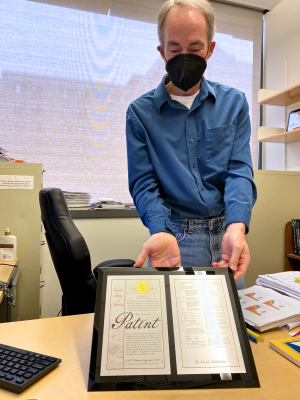Working together, researchers and industry are on the verge of revolutionizing how we treat concussions and brain injuries
After years of development and study, a patent was recently issued to Quadrant Biosciences, SUNY Research Foundation, and Penn State College of Medicine for a saliva test that can analyze the occurrence of mild traumatic brain injuries and concussion symptoms. This project is just the most recent development in the incredible partnership between SUNY Upstate researchers and Quadrant Biosciences, showing how beneficial these partnerships can be and the revolutionary work they can produce.

Dr. Frank Middleton shows the patent recently issued for a saliva test for concussions.
“The way things have been assessed for too long has ignored too many things. We've had walking wounded in our midst; the silent pandemic, traumatic brain injuries,” explains SUNY Upstate’s Frank Middleton, PhD.
This project began as an attempt to find a rapid way to determine when someone has experienced head trauma beyond a certain level of force. Collaborating with the concussion clinic, they added saliva profiling to an ongoing project that was studying the blood of mixed martial arts fighters.
“What we were able to do in the first saliva study that we published was identify what are called microRNAs, or small RNAs in the saliva that changed;” Middleton explains. “Not as a function of performance during training, but as a function of getting hit in the head in the fight.” Not only were they able to detect these changes, but tests showed they were identifiable in saliva faster than in bloodwork.
How will this saliva test be used? Middleton describes its use as two-fold; not only can it detect the occurrence of a traumatic event, but it can also help predict the course of recovery and the delayed onset of post-concussive symptoms.
Middleton describes one of the biggest dangers as repeat injuries, which could occur if someone who experiences head trauma is unaware of an injury that may not be fully healed.
“If they're not right, it means their brain is still vulnerable, more vulnerable than it was prior to the first injury. Repetitive injuries occurring in that scenario? That's the real demon that we're trying to do something about.”
Administering multiple tests that can detect and measure microRNAs could be a powerful tool used by doctors to help gauge the severity of the injury and how recovery is progressing, similar to how hemoglobin can be measured to track blood sugar. Right now, Quadrant Biosciences and researchers are conducting a multi-site study, collecting thousands of samples taken from a wide cross-section of people who experienced injury weeks prior, and the outcome of their trauma is known. This data will be crucial to using these tests to analyze results.
Middleton credits the benefits of partnering with a private company like Quadrant with the speed at which they’ve been able to move the saliva test from concept to commercialization. Specifically, these working conditions have allowed both flexibility and speed. He explains that while a traditional academic timeline for a project like this can be five years or more, Quadrant recognized the potential of a concussion test, and “in the space of a week funding was set up. The account was spendable. And we were collecting samples.”
“That flexibility doesn't happen, and that type of instant funding doesn't happen unless you have a small business partner. They're motivated,” Middleton says. “That's been my experience in the work relationship I've had with Quadrant. Every step of the way they’ve been very supportive and open to ideas. Flexible when we needed to change directions slightly or flexible to take the same approach and apply it to a different disorder.”
Middleton points out that It’s not just medical researchers that benefit from this type of partnership. “It's easier for them, we've known this for decades, to partner with an academic that already has an established program that may have a near market-ready product or has shown promise already.”
Quadrant agrees that partnering with SUNY Upstate has been extremely beneficial in past and current projects.
“The collaboration between SUNY Upstate and Quadrant has led to important breakthroughs in the development of saliva-based diagnostic solutions for neurological conditions such as autism spectrum disorder and concussion injuries,” says Ben Perry, CO-CEO of Quadrant. “Early in the SARS-CoV-2 pandemic, we transferred this innovative approach to address the need for COVID-19 testing solutions, further demonstrating the critical importance of working with an academic institution like SUNY Upstate.”
So what are the next steps for this test now that they’ve been granted this patent? Quadrant says they plan to launch it under the name Clarifi mTBI in New York by late 2023, before expanding nationwide in 2024. “Between now and the end of the year, the test is undergoing its final development before being commercially available,” says Perry.
Middleton quickly points out that the concussion test is only scratching the surface of what these microRNA saliva tests could potentially do in the future.
“There’s this whole class of RNAs that we've realized are really pulling the strings. We didn’t know they existed at all until well after the year 2000; they were not in my college textbooks.” Middleton theorizes this technology could be applied to a wide range of autoimmune conditions from multiple sclerosis, lupus, arthritis, and possibly even Parkinson’s disease.
“It's great when you realize how much you don't know; you're sort of entering a field that was undiscovered country and we're learning new things every time we turn over a rock or look under a leaf.”